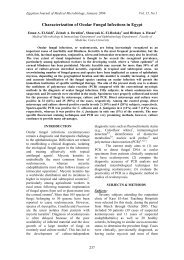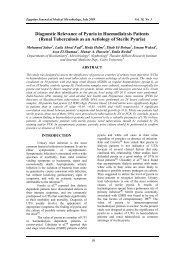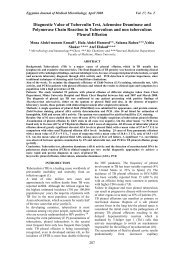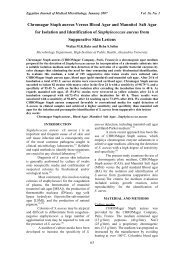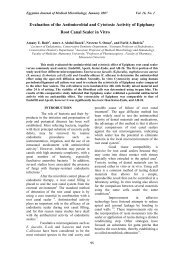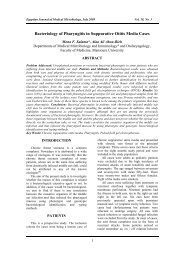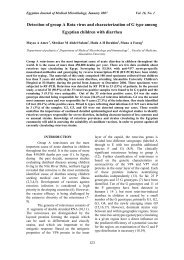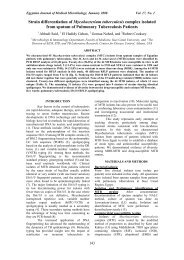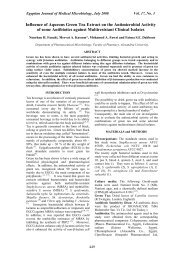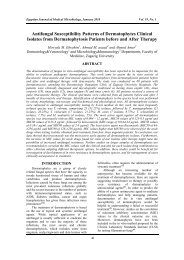Application of Pulsed Field Gel Electrophoresis (PFGE) for Typing of ...
Application of Pulsed Field Gel Electrophoresis (PFGE) for Typing of ...
Application of Pulsed Field Gel Electrophoresis (PFGE) for Typing of ...
Create successful ePaper yourself
Turn your PDF publications into a flip-book with our unique Google optimized e-Paper software.
Egyptian Journal <strong>of</strong> Medical Microbiology, July 2006 Vol. 15, No 3<br />
<strong>Application</strong> <strong>of</strong> <strong>Pulsed</strong> <strong>Field</strong> <strong>Gel</strong> <strong>Electrophoresis</strong> (<strong>PFGE</strong>) <strong>for</strong> <strong>Typing</strong> <strong>of</strong><br />
Stenotrophomonus maltophilia Isolated from Nosocomial Ventilator<br />
Associated Pneumonia In ICU Patients<br />
Abeer Ezzat El-Sayed Mohamed<br />
Microbiology and Immunology Department Suez Canal University,<br />
Faculty <strong>of</strong> Medicine, Ismailia, Egypt.<br />
Stenotrophomonus maltophilia is a multidrug resistant nosocomial pathogen <strong>for</strong> which optimal<br />
typing methods are needed to estimate epidemiologic relatedness especially among Intensive Care<br />
Unit (ICU). Ventilator associated pneumonia (VAP) is a common complication in mechanically<br />
ventilated patients and it is accompanied by increased mortality. <strong>Pulsed</strong> field gel electrophoresis<br />
(<strong>PFGE</strong>) was applied to 12 nosocomial strains isolated from patients had VAP and six<br />
environmental specimens in ICU in Bahrain Hospital over 15 months period in 2004-2005.<br />
Antibiogram as a phenotypic marker failed to discriminate between these isolates. Five<br />
antibiogram patterns were identified among 18 isolates with predominance <strong>of</strong> pattern (I) that<br />
resisted five chemotherapeutic agents in 5 isolates (27.8%). All the strains were sensitive to<br />
trimethoprim–sulfamethoxazole but only 72.2%, 55.6%, 44.4%, 22.2% and 11.1% were sensitive<br />
to minocycline, lev<strong>of</strong>loxacin, ticarcillin–clavulanic acid, ceftazidime and chloramphenicol<br />
respectively. All the strains were typable by the genotypic marker <strong>PFGE</strong>. It revealed 14 patterns<br />
among 18 clinical and innate environmental isolates with a small two clusters included 3 strains<br />
that were epidemiologically related. Ten genotypic patterns were detected among twelve clinical<br />
isolates meanwhile six patterns were detected among the six environmental isolates. There were<br />
similar isolated <strong>PFGE</strong> patterns between environmental and clinical isolates suggestive <strong>of</strong> the source<br />
<strong>of</strong> infection to those patients and evidence <strong>of</strong> patient to patient transmission.These different<br />
genotypic patterns indicated different sources and genetic diversity <strong>of</strong> this opportunistic pathogen.<br />
This study proved high typability, sensitivity and discriminatory power <strong>of</strong> <strong>PFGE</strong> method <strong>for</strong> typing<br />
<strong>of</strong> nosocomial Stenotrophomonus maltophilia. It is recommended to add another genotypic marker<br />
in further studies like random amplified polymorphic DNA analysis (RAPD) to increase and<br />
augment the sensitivity and discriminatory power <strong>for</strong> typing <strong>of</strong> this important pathogen and trace<br />
the different sources <strong>of</strong> nosocomial infection.<br />
INTRODUCTION<br />
Stenotrophomonus maltophilia is an<br />
aerobic non-fermentative gram negative<br />
bacillus that is generally considered an<br />
opportunistic pathogen<br />
(1) . Ventilator<br />
associatd pneumonia (VAP) is a common<br />
complication in mechanically ventilated<br />
patients and it is accompanied by increased<br />
mortality<br />
(2) . Patients compromised by<br />
debilitating illness, surgical procedures,<br />
indwelling catheters or on mechanical<br />
ventilator are most prone to<br />
(2,<br />
Stenotrophomonus maltophilia<br />
3) . It is<br />
considered one <strong>of</strong> nosocomial pathogen that<br />
plays an important role in respiratory tract<br />
infections and other nosocomial infections<br />
among critically ill patients (3, 4) . VAP is the<br />
most frequently observed nosocomial<br />
infection among mechanically ventilated<br />
intensive care unit (4, 5) . Stenotrophomonus<br />
maltophilia is a multidrug resistant organism<br />
<strong>for</strong> which optimal typing methods are needed<br />
as epidemiological investigations <strong>of</strong><br />
nosocomial VAP outbreaks<br />
(5-9) . Long<br />
duration <strong>of</strong> endotracheal intubation leads to<br />
acquisition <strong>of</strong> potentially pathogenic<br />
organisms from the intensive care unit<br />
environment Antibiogram to this organism is<br />
less reliable since these isolates are frequently<br />
resistant to multiple antibiotics (6) . This study<br />
aimed to use DNA macrorestriction analysis<br />
by pulsed field gel electrophoresis (<strong>PFGE</strong>) as<br />
genotypic marker <strong>for</strong> typing <strong>of</strong> 12 nosocomial<br />
strains caused ventilator associated<br />
pneumonia and six innate environmental<br />
strains from ICU <strong>of</strong> Bahrain Hospital. <strong>PFGE</strong><br />
can resolve much larger DNA fragments than<br />
conventional electrophoresis and has been<br />
found to be a highly discriminatory technique<br />
<strong>for</strong> strain differentiation compared to<br />
phenotypic methods like antibiogram,<br />
biotyping, serotyping and multilocus enzyme<br />
electrophoresis (5-10) .<br />
504
Egyptian Journal <strong>of</strong> Medical Microbiology, July 2006 Vol. 15, No 3<br />
PATIENTS, MATERIALS AND<br />
METHODS<br />
This study was carried out on<br />
mechanically ventilated patients admitted to<br />
the ICU <strong>of</strong> Bahrain Hospital that developed<br />
nosocomial VAP either early onset (Less than<br />
5 days <strong>of</strong> intubation) or late onset (≥ 5 days <strong>of</strong><br />
intubation), during the period from January,<br />
2004 to March, 2005. Patients were subjected<br />
to thorough clinical examination, routine<br />
laboratory investigations, chest<br />
roentgenography and gasometry. VAP was<br />
diagnosed according to the clinical pulmonary<br />
infection score (CPIS) system <strong>of</strong> Garrard and<br />
Court (11) . It included body temperature, blood<br />
leukocytes, tracheal aspirates appearance and<br />
quantity per day, oxygenation, pulmonary<br />
radiography and culture <strong>of</strong> tracheal aspirates.<br />
Inclusion criteria:-<br />
Patients on mechanical ventilator who were<br />
diagnosed as nosocomial VAP ≥ 48 hrs after<br />
intubation according to Clinical Pulmonary<br />
Infection Score (CPIS). The range <strong>of</strong> the<br />
score is from 0 to 12 points with VAP defined<br />
by score <strong>of</strong> 7 or above (10, 11) . Clinical data<br />
from every patient were collected regarding<br />
age, sex, time <strong>of</strong> admission, duration <strong>of</strong><br />
hospitalization, duration <strong>of</strong> intubation,<br />
presence <strong>of</strong> organ failure and any chronic<br />
illness. Environmental swabs were taken from<br />
surfaces, walls, water <strong>of</strong> humidifier, tubes<br />
from ventilator circuits and side tables. The<br />
swabs were plated on blood and<br />
MacConkey`s agar plates then incubated<br />
aerobically at 35 °C <strong>for</strong> 24 hrs <strong>for</strong> subsequent<br />
identification <strong>of</strong> the organism by colonial<br />
morphology and biochemical reactions.<br />
Quantitative culture <strong>of</strong> endotracheal<br />
aspirate (EA) (12) :- The endotracheal aspirate<br />
secretions (EA) were collected in sterile<br />
containers and immediately were sent to the<br />
microbiology laboratory then were liquefied<br />
and homogenized by adding an equal volume<br />
<strong>of</strong> sterile 1% N-acetyl-L-cysteine (Sigma)<br />
solution vortexing <strong>for</strong> 2 minutes and<br />
incubating at room temperature <strong>for</strong> 10<br />
minutes.<br />
The homogenized respiratory secretions<br />
were serially 10 fold diluted in sterile broth<br />
and 2 dilutions (1/100 and 1/1000) were<br />
inoculated in 10 µL volumes onto blood agar<br />
and MacConkey`s agar plates then incubated<br />
aerobically at 35 °C <strong>for</strong> 24 hrs. The bacterial<br />
isolates were identified by being gram<br />
negative bacilli using gram staining technique,<br />
non-lactose fermenter and oxidase negative.<br />
The suspected bacteria were further identified<br />
in addition to colonial morphology by using<br />
(13)<br />
API 20 NE (BioMerieux, France)<br />
according to the manufacture instructions.<br />
Significant bacterial count was considered ≥<br />
10 6 CFU/ml.<br />
Bacterial strains were collected after<br />
identification and preserved in two tubes one<br />
in 1% trypticase soy agar incubated at 37 °C<br />
<strong>for</strong> 24 hrs. The other in trypticase soy broth<br />
with 13% glycerol as cryoprotectant then kept<br />
at -70 °C until processed <strong>for</strong> <strong>PFGE</strong>.<br />
Antibiotic susceptibility pattern was done<br />
to each isolate by disk diffusion according to<br />
Clinical and Laboratory Standards Institute<br />
guideline instructions (CLSI, 2005) (14) using<br />
the following disks :- trimethoprimsulphamesoxazole<br />
(1.25/3.75µg), minocycline<br />
(30µg), lev<strong>of</strong>loxacin (5 µg), ticarcillin–<br />
clavulanic acid (75/ 10µg), ceftazidime (30<br />
µg) and Chloramphenicol (30 µg).<br />
<strong>PFGE</strong> analysis<br />
Genomic DNA was prepared according<br />
to Laing et al. (15) . The bacterial isolates were<br />
grown <strong>for</strong> 18 h in 5 ml <strong>of</strong> brain heart infusion<br />
broth (Difco) at 37 °C. The cells were<br />
harvested and suspended in 1.5 ml <strong>of</strong> buffer<br />
[1M NaCl, 10 mM Tris-Hcl (pH 7.6)]. One<br />
milliliter <strong>of</strong> this suspension was mixed with 1<br />
ml <strong>of</strong> 1.6 % low- melting temperature agarose<br />
at 50 °C (Imbed LMP agarose, New England<br />
Biolabs, Beverly, Mass), then pipetted into a<br />
plug mold (Bio-Rad Lab. Richmond, Calif.)<br />
and allowed to solidify <strong>for</strong> 30 min at 4 °C.<br />
Plugs were placed in 1.5 ml <strong>of</strong> fresh cold lyis<br />
solution (10 mMTris-Hcl (pH 7.6), 50mM<br />
NaCl, 100 mM EDTA (pH 8.0), 0.2%<br />
deoxycholic acid (Sigma Chemical Co. St.<br />
Louis, Mo), 1% N-Lauroyl sarcosine (Sigma)<br />
and 2 mg <strong>of</strong> lysozyme (Sigma) per ml) <strong>for</strong> 3 h<br />
at 35 °C. Samples were treated <strong>for</strong> 16 h at 42<br />
°C with the same volume <strong>of</strong> a proteinase K<br />
solution containing 50 µg <strong>of</strong> proteinase K<br />
(Boehringer Mannheim, Laval, Quebec,<br />
Canada) per ml, 100 mM EDTA (pH 8.0),<br />
0.2% deoxycholic acid and 1% N-Lauroyl<br />
sarcosine. After three 1-hour washes with TE<br />
buffer [10 mM Tris-Hcl, 0.1 mM EDTA (pH<br />
8.0)], the agarose plugs were stored in TE<br />
buffer at 4 °C <strong>for</strong> subsequent <strong>PFGE</strong>.<br />
505
Egyptian Journal <strong>of</strong> Medical Microbiology, July 2006 Vol. 15, No 3<br />
A 5 mm slice <strong>of</strong> an agarose plug was<br />
digested with 20 U restriction enzyme SpeI<br />
(Boehringer Mannheim) and incubated <strong>for</strong> 20<br />
h at 37 °C in a reaction volume <strong>of</strong> 0.25 ml<br />
according to the manufacturer ’ s<br />
recommendations. The resultant DNA<br />
fragments were separated on a 1% <strong>PFGE</strong><br />
agarose (FastLane agarose; FMC, Rockland,<br />
Main), gel in a contour-clamped homogenous<br />
electrical field by using the CHEF DR-II<br />
system (Bio-Rad), with 0.5xTBE buffer [45<br />
mM Tris-borate, 1 mM EDTA (pH 8.0)] at 12<br />
°C. With the voltage set at 6.0 V/cm, Initial<br />
and final switch times were 25 to 45 seconds<br />
respectively with linear ramping factor and a<br />
run time <strong>of</strong> 20 hrs. Bacteriophage lambda<br />
concatemers (Mid-range; New England<br />
Biolabs) were run as molecular weight<br />
standards (range 50-1,000 Kb). <strong>Gel</strong>s were<br />
visualized with UV light after staining with<br />
ethidium bromide (10µg /ml) and<br />
photographed using Polaroid camera. Isolates<br />
were differentiated by visual inspection <strong>of</strong><br />
<strong>PFGE</strong> patterns on the agarose gels and were<br />
considered different if their <strong>PFGE</strong> patterns<br />
differed by more than one DNA band.<br />
Statistical analysis:-<br />
Statistical analysis was per<strong>for</strong>med using the<br />
Statistical Package <strong>for</strong> Social Sciences (SPSS<br />
version 10) (16) . The mean and standard<br />
deviation (SD) were used <strong>for</strong> numerical data<br />
<strong>for</strong> description.<br />
RESULTS<br />
This study was carried out on 18<br />
stenotrophomonus maltophilia isolates from<br />
clinical and environmental specimens through<br />
15 months. Twelve clinical isolates were<br />
isolated from 36 (33.3%) tracheal aspirates <strong>of</strong><br />
patients with nosocomial VAP after 48 hrs <strong>of</strong><br />
intubation. Most <strong>of</strong> studied patients [30 out<br />
<strong>of</strong> 36 (83.3%)], had late onset pneumonia that<br />
was after or on fifth day <strong>of</strong> intubation. Ten<br />
patients (83.3%) out <strong>of</strong> twelve infected with<br />
stenotrophomonus maltophilia had late onset<br />
pneumonia. Eight patients out <strong>of</strong> 36 (22.2%)<br />
had polymicrobial VAP. Three patients out <strong>of</strong><br />
twelve (25%) had polymicrobial pathogens<br />
with Stenotrophomonus maltophilia. Two<br />
patients had pseudomonus aeroginosa and<br />
one patient had staphylococcus aureus<br />
pathogen. Six environmental strains were<br />
isolated from walls, water <strong>of</strong> humidifier,<br />
outside tube <strong>of</strong> one ventilator circuit and side<br />
table in ICU. Age <strong>of</strong> the patient ranged from<br />
44-86 years old with mean (59±12). Twenty<br />
two patients were males (61.1%) and 14<br />
(38.9%) were females. The mean duration <strong>of</strong><br />
mechanical ventilation be<strong>for</strong>e suspicion <strong>of</strong><br />
pneumonia was 10.3±5.2 days (range 2-45<br />
days). The mean and standard deviation <strong>of</strong><br />
CPIS values were 10±2 among 36 patients<br />
who had VAP. The indications <strong>for</strong><br />
mechanical ventilator in table (1), included<br />
metabolic causes in 6 patients (16.7%), as<br />
renal failure and diabetic ketoacidosis.<br />
Pulmonary diseases as severe bronchial<br />
asthma, neoplasm and chronic obstructive<br />
pulmonary disease were in 14 patients<br />
(38.9%). Cardiac failure was in 4 patients<br />
(11.1%). Cerebrovascular accidents were in 7<br />
patients (19.4 %) and head trauma in 5<br />
patients (13.9 %).<br />
Table (1): Indications <strong>of</strong> Mechanical<br />
Ventilation In The Studied<br />
Patients:<br />
Indications <strong>of</strong> mechanical No.= %<br />
ventilation<br />
36<br />
Metabolic causes 6 16.7<br />
Pulmonary diseases 14 38.9<br />
Cardiac failure 4 11.1<br />
Cerebrovascular accidents 7 19.4<br />
Head trauma 5 13.9<br />
Fifteen out <strong>of</strong> the 36 studied patients (41.7%),<br />
VAP was associated with a clinical<br />
presentation <strong>of</strong> severe sepsis or septic shock.<br />
Five (13.9%) <strong>of</strong> those patients were infected<br />
by Stenotrophomonus maltophilia. Those<br />
patients represented 41.7% from twelve cases<br />
infected with this pathogen.<br />
All the strains were sensitive to<br />
trimethoprim-sulphamesoxazole but only<br />
72.2%, 55.6%, 44.4%, 22.2% and 11.1% were<br />
sensitive to minocycline, lev<strong>of</strong>loxacin,<br />
ticarcillin–clavulanic acid, ceftazidime and<br />
chloramphenicol respectively. Antibiogram<br />
failed to discriminate between the clinical and<br />
environmental isolates as these organisms<br />
were multidrug resistant. Five antibiogram<br />
patterns were detected among total 18 isolates<br />
with similarity between clinical and<br />
environmental isolates table (2). The most<br />
predominating pattern was pattern (I) that<br />
resists five chemotherapeutic agents in five<br />
isolates out <strong>of</strong> 18 strains (27.8%).<br />
506
Egyptian Journal <strong>of</strong> Medical Microbiology, July 2006 Vol. 15, No 3<br />
Table (2): Antimicrobial Susceptibility<br />
Patterns to Clinical and<br />
Environmental Isolates.<br />
Antimicrobial<br />
susceptibility pattern<br />
I<br />
II<br />
III<br />
IV<br />
V<br />
Antimicrobial agents<br />
that Isolates are R<br />
Min,LEV,C,CAZ,TIM<br />
LEV,C,CAZ,TIM<br />
CAZ,TIM<br />
CAZ,C<br />
C<br />
R=resistant,<br />
LEV=lev<strong>of</strong>loxacin,<br />
CAZ=ceftazidime,<br />
TIM=ticarcillin/clavulanic acid.<br />
Clinical Isolates<br />
4<br />
2<br />
2<br />
2<br />
2<br />
Environmental<br />
Isolates<br />
1<br />
1<br />
0<br />
2<br />
2<br />
Min=minocycline,<br />
C=chloramphenicol,<br />
DNA restriction analysis with SpeI and<br />
subsequent <strong>PFGE</strong> showed fourteen different<br />
genotypic patterns as shown in table (3) and<br />
figure (1). Six different patterns were found<br />
among innate environmental isolates with<br />
similarity in patterns D, I with clinical isolates.<br />
Ten genotypic patterns were detected among<br />
twelve clinical isolates with two similar<br />
clones <strong>of</strong> clinical isolates in pattern D, I.<br />
Table (3): <strong>PFGE</strong> Patterns <strong>of</strong> Clinical and<br />
Environmental Isolates.<br />
<strong>PFGE</strong> Clinical Environmental<br />
Patterns No. % No. %<br />
A 1 8.3 0 0<br />
B 0 0 1 16.7<br />
C 1 8.3 0 0<br />
D 2 16.7 1 16.7<br />
E 1 8.3 0 0<br />
F 1 8.3 0 0<br />
G 0 0 1 16.7<br />
H 0 0 1 16.7<br />
I 2 16.7 1 16.7<br />
J 1 8.3 0 0<br />
K 1 8.3 0 0<br />
L 1 8.3 0 0<br />
M 1 8.3 0 0<br />
N 0 0 1 16.7<br />
Total 12 100 6 100<br />
Figure (1): <strong>PFGE</strong> Patterns <strong>of</strong> Clinical and<br />
Environmental Isolates by<br />
Agarose <strong>Gel</strong> <strong>Electrophoresis</strong>.<br />
Lane 1,20 : DNA standard ladder <strong>of</strong> Lambda<br />
phage DNA marker from 50-1,000KB. Lane 2<br />
pattern A, lane3 pattern B, lane 4 pattern C,<br />
Lane 5,13, 17 pattern D, lane 6 pattern E, lane<br />
7 pattern F, lane 8 pattern G, lane 9 pattern H,<br />
lane 10,11,12 pattern I, lane 14 pattern J, lane<br />
15 pattern K, lane 16 pattern L, lane 18<br />
pattern M,lane 19 pattern N. Number <strong>of</strong><br />
bands ranged from 10-14 bands.<br />
DISCUSSION<br />
Episodes <strong>of</strong> infections caused by<br />
Stenotrophomonus maltophilia have become<br />
increasingly important in the hospital setting<br />
especialy among ICU patients. VAP is<br />
thought to increase the lengh <strong>of</strong> stay in the<br />
ICU, mortality, morbidity and the costs<br />
attributed to it are there<strong>for</strong>e high (2, 3, 5, 9) .<br />
Tracheal colonization caused by potentially<br />
pathogenic microorganisms occurs prior to<br />
lung infection in many patients admitted to<br />
intensive care units. Stenotrophomonus<br />
maltophilia is one <strong>of</strong> important nosocomial<br />
pathogens causing multidrug-resistant<br />
infections in hospitalized patients (1, 2) , Most<br />
<strong>of</strong> the cases 30/36 had late onset VAP (83.3%)<br />
that developed after or on the fifth day <strong>of</strong><br />
intubation. Ten (83.3%) out <strong>of</strong> twelve cases<br />
infected by Stenotrophomonus maltophilia<br />
had late onset VAP this may be due to<br />
colonization <strong>of</strong> this potentially pathogenic<br />
organism in respiratory secretions or<br />
endotracheal tube bi<strong>of</strong>ilm <strong>for</strong>mation that<br />
plays a contributing role in sustaining tracheal<br />
colonization. These previous results agreed<br />
with Safdar et al. (9) that explained the<br />
pathogenesis <strong>of</strong> the development <strong>of</strong> VAP<br />
507
Egyptian Journal <strong>of</strong> Medical Microbiology, July 2006 Vol. 15, No 3<br />
caused by this potentially pathogenic<br />
organism that may be acquired from the<br />
intensive care unit environment and under<br />
certain debilitating factors it leads to infection.<br />
In the present study 36 patients in ICU<br />
diagnosed <strong>of</strong> nosocomial VAP were included<br />
using quantitative EA culture and CPIS<br />
values. Most <strong>of</strong> the included patients were old<br />
age with chronic illness, exposure to invasive<br />
techniques, long hospital stay, bedridden and<br />
with long duration <strong>of</strong> intubation, suggestive<br />
<strong>of</strong> the predisposing factors <strong>for</strong> development <strong>of</strong><br />
VAP (9, 17-18) . Five patients out <strong>of</strong> twelve<br />
(41.7%) infected with Stenotrophomonus<br />
maltophilia had severe sepsis and septic<br />
shock donating the severity and importance <strong>of</strong><br />
this pathogen among such illness and this<br />
supports what has been observed in previous<br />
studies (9, 17-20) . It is possible to use the time <strong>of</strong><br />
occurrence <strong>of</strong> VAP as an important indicator<br />
<strong>of</strong> mortality and may be used to identify<br />
patients at risk and initiate appropriate<br />
therapy at an earlier stage especially that<br />
studied patients had long intubation time with<br />
mean and SD <strong>of</strong> 10.3±5.2 days. Twelve<br />
strains <strong>of</strong> Stenotrophomonus maltophilia were<br />
isolated from 36 patients (33.3%) within 15<br />
months among patients in ICU <strong>of</strong> Bahrain<br />
Hospital. This showed the importance <strong>of</strong> this<br />
pathogen among critically ill patients. Three<br />
patients out <strong>of</strong> twelve infected with<br />
Stenotrophomonus maltophilia (25%) had<br />
other pathogens that were polymicrobial. Two<br />
patients had pseudomonus aeroginosa and<br />
one had staphylococcus aureus. This result<br />
(3, 19,<br />
has been emphasized by several authors 20) . This reflects the pattern <strong>of</strong> microbial<br />
infection among critically ill patient as they<br />
are exposed to multiple pathogens and these<br />
results coincide with Bedewy et al. (20) .<br />
Different innate environmental swabs were<br />
taken in ICU and six strains were detected<br />
suggestive <strong>of</strong> the different sources <strong>of</strong><br />
infection that were from water <strong>of</strong> the<br />
humidifier, walls, side tables and tubes <strong>of</strong> the<br />
ventilator circuits. Isolation <strong>of</strong> this pathogen<br />
from the environment assures that infection<br />
control measures regarding regular<br />
disinfection <strong>of</strong> the environment have great<br />
role in prevention <strong>of</strong> VAP (21) . This study also<br />
proved the role <strong>of</strong> the special care with<br />
patients on mechanical ventilator <strong>for</strong><br />
prophylaxis against VAP (22) . Pulmonary<br />
diseases (severe bronchial ashma, neoplasm<br />
and chronic obstructive lung diseases)<br />
represented the highest percentage (38.9%)<br />
(table, 1) among 36 patients indicated <strong>for</strong><br />
mechanical ventilation. This estimated the<br />
risk factors <strong>for</strong> development <strong>of</strong> VAP and<br />
subsequently infection with this opportunistic<br />
pathogen. All the 18 isolates were susceptible<br />
to trimethoprim-sulphamesoxazole but only<br />
72.2%, 55.6%, 44.4%, 22.2% and 11.1% were<br />
sensitive to minocycline, lev<strong>of</strong>loxacin,<br />
ticarcillin–clavulanic acid, ceftazidime and<br />
chloramphenicol<br />
respectively.<br />
Stenotrophomonus maltophilia is notoriously<br />
resistant to most currently available<br />
antimicrobial agents leaving trimethoprimsulfamethoxazole<br />
as the primary drug <strong>of</strong><br />
choice <strong>for</strong> infections caused by this species (5,<br />
6, 10).<br />
Antibiogram failed to discriminate<br />
between the clinical and environmental<br />
isolates as this organism is considered one <strong>of</strong><br />
multidrug resistant pathogens and this agree<br />
with previous studies (5, 6, 17-19) . This study<br />
suggests that hospitals represent a wellestablished<br />
reservoir <strong>for</strong> resistant organisms<br />
due to misuse <strong>of</strong> antibiotics among critically<br />
ill patients (5, 19, 22, 23) . Pattern (I) was the most<br />
predominating antimicrobial suceptibility<br />
pattern in five isolates (27.8%) that resist five<br />
agents (table, 3). For that reason using<br />
antibiogram alone is not sufficient <strong>for</strong><br />
discrimination between closely related<br />
isolates and needs to be powered by other<br />
genotypic markers.<br />
All 18 Stenotrophomonus maltophilia<br />
isolates were typeable by <strong>PFGE</strong> using SpeI<br />
restrictive enzyme. Fourteen genotypic<br />
patterns were detected among total clinical<br />
and environmental isolates with 2 small<br />
clones included three strains in patterns D, I.<br />
Pattern D included 2 clinical isolates that<br />
were isolated from 2 patients cohorting the<br />
same room with near beds, suggestive <strong>of</strong> the<br />
patient to patient transmission <strong>of</strong> infection.<br />
One innate environmental strain isolated from<br />
the water <strong>of</strong> humidifier had similar <strong>PFGE</strong><br />
pattern D (table, 3) wth 2 clinical isolates.<br />
From the previous result the source <strong>of</strong><br />
infection is traced to some patients and<br />
infection control preventive measures were<br />
important to prevent development <strong>of</strong><br />
nosocomial outbreaks. Pattern I also included<br />
three strains with 2 clinical and one<br />
environmental isolated from the wall <strong>of</strong> the<br />
ventilator tube circuits. Isolation <strong>of</strong> the same<br />
genotype from the tube <strong>of</strong> the ventilator<br />
indicates that it may be the source <strong>of</strong> infection<br />
508
Egyptian Journal <strong>of</strong> Medical Microbiology, July 2006 Vol. 15, No 3<br />
or contamination from the patient secretions<br />
but there is possibility <strong>of</strong> patient to patient<br />
transmission <strong>of</strong> this organism. This study<br />
proved the high discriminatory and sensitivity<br />
power <strong>of</strong> <strong>PFGE</strong> marker <strong>for</strong> typing <strong>of</strong><br />
Stenotrophomonus maltophilia beside its<br />
ability <strong>for</strong> identification <strong>of</strong> nosocomial<br />
sources suggesting multiple independent<br />
acquisitions from a variety <strong>of</strong> environmental<br />
sources.This agree with Yao et al,<br />
(24) ,<br />
Gordillo et al., (25) and Mazloum et al., (26) as<br />
they found that <strong>PFGE</strong> was superior to other<br />
techniques <strong>for</strong> typing <strong>of</strong> nosocomial isolates.<br />
There was no outbreak detected with<br />
Stenotrophomonus maltophilia during 15<br />
months inside ICU but <strong>PFGE</strong> genotypic<br />
technique proved the genetic diversity <strong>of</strong> this<br />
microbe and thus the different sources <strong>of</strong><br />
infection. These results coincide with<br />
previous studies (5, 15, 27-31) . From the previous,<br />
it is recommended to use <strong>PFGE</strong> method as a<br />
discriminatory genotypic technique <strong>for</strong> typing<br />
nosocomial pathogens, estimation <strong>of</strong> the<br />
genetic relatedness and tracing the sources <strong>of</strong><br />
infection by this pathogen. Another genotypic<br />
marker like random amplified polymorphic<br />
DNA analysis (RAPD), using a single<br />
arbitrary oligonucleotide primer selected <strong>for</strong><br />
its ability to discriminate among<br />
epidemiologically distinct isolates (30, 32, 33) . It<br />
could be added <strong>for</strong> typing <strong>of</strong> this organism as<br />
an attempt to augment the sensitivity and<br />
discriminatory power <strong>of</strong> <strong>PFGE</strong> method and to<br />
trace the different sources <strong>of</strong> infection.<br />
REFERENCES<br />
1. Swings J, De Vos P, Van den Mooter<br />
and DeLey J (1983): Transfer <strong>of</strong><br />
Pseudomonus maltophilia Hugh 1981 to<br />
the genus Xanthomonus as Xanthomonus<br />
maltophilia (Hugh 1981) comb. Int. J<br />
Syst. Bacteriol; 33:409-413.<br />
2. Elting LS, Khardori N, Bodey GP and<br />
Fainstein V (1990): Nosocomial<br />
infection caused by Xanthomonus<br />
maltophilia: a case–control study <strong>of</strong><br />
predisposing factors. Infect Control Hosp<br />
Epidemiol; 11: 134-138.<br />
3. Elting LS and Bodey GP (1990):<br />
Septicemia due to Xanthomonus species<br />
and non-aeroginosa pseudomonus species:<br />
increasing incidence <strong>of</strong> catheter related<br />
infections. Medicine (Baltimore); 69:<br />
296-306.<br />
4. Graff GR and Burns JL (2002): Factors<br />
affecting the incidence <strong>of</strong><br />
Stenotrophomonus maltophilia isolation<br />
in cystic fibrosis. Chest; 121: 1754-1760.<br />
5. Sader HS, Pignatari R, Frei R, Hollis<br />
RJ and Jones RN (1994): <strong>Pulsed</strong> field<br />
gel electrophoresis <strong>of</strong> restriction-digested<br />
genomic DNA and antimicrobial<br />
susceptibility <strong>of</strong> Xanthomonus<br />
maltophilia strains from Brazil,<br />
Switzerland and the USA. J<br />
Antimicrobial Chemother; 33: 615-618.<br />
6. Brun-Buisson C (2003): Antibiotic<br />
theray <strong>of</strong> ventilated-associated pneumonia:<br />
in search <strong>of</strong> the magic bullet. Chest; 123:<br />
670-673.<br />
7. Schable B, Rhoden DL, Hugh R,<br />
Weaver RE, Khardori N, Smith PB,<br />
Bodey GP and Anderson RL (1989):<br />
Serological classification <strong>of</strong> Xanthomonus<br />
maltophilia (pseudomonus maltophilia)<br />
based on heat-stable O antigens. J Clin<br />
Microbiol; 27: 1011-1014.<br />
8. Schable B, Villarino ME, Favero MS<br />
and Miller JM (1991): <strong>Application</strong> <strong>of</strong><br />
multilocus enzyme electrophoresis to<br />
epidemiologic investigations <strong>of</strong><br />
Xanthomonus maltophilia. Infect Cont<br />
Hosp Epidemiol; 12(3): 163-167.<br />
9. Safdar N, Crnich CJ and Maki DG<br />
(2005): The pathogenesis <strong>of</strong> ventilator<br />
associated pneumonia: its relevance to<br />
developing effective strategies <strong>for</strong><br />
prevention.Respir Care 50(6):725-739.<br />
10. Pankuch GA, Jacobs MR, Rittenhouse<br />
SF, et al. (1994): Susceptibilities <strong>of</strong> 123<br />
strains <strong>of</strong> Xanthomonus maltophilia to<br />
eight B-lactams(including B-lactam- B-<br />
lactamase inhibitor combinations) and<br />
cipr<strong>of</strong>loxacin tested by five methods,<br />
Antimicrob Agents Chemother; 38: 2317.<br />
11. Garrard CS and Court CDA (1995):<br />
The diagnosis <strong>of</strong> pneumonia in the<br />
critically ill. Chest; 108: 17S-25S.<br />
12. Marquette CH, George H, Wallet F,<br />
Ramon P, Saulnier F, Neviere R,<br />
Mathieu D, Rime A and Tonnel AB<br />
(1993): Diagnostic efficiency <strong>of</strong><br />
endotracheal aspirates with quantitative<br />
bacterial cultures in intubated patients<br />
with suspected pneumonia. Am Rev<br />
Respir Dis; 148: 138-144.<br />
13. Govan JRW (1996): Pseudomonus,<br />
Stenotrophomonus maltophilia,<br />
Burkholderia. In:Collee JG, Fraser AG,<br />
509
Egyptian Journal <strong>of</strong> Medical Microbiology, July 2006 Vol. 15, No 3<br />
Marmion BP and Simmons A, eds.<br />
Mackie & McCartney practical Medical<br />
Microbiology. Tests <strong>for</strong> identification <strong>of</strong><br />
bacteria. Stenotrophomonus maltophilia 4<br />
th ed. New York. Churchill Livingstone;<br />
413-424.<br />
14. Clinical and Laboratory Standards<br />
Institute (CLSI) (2005):Per<strong>for</strong>mance<br />
Standards <strong>for</strong> Antimicrobial<br />
susceptibility testing; fifetenth<br />
in<strong>for</strong>mational supplement, M100-S15<br />
vol.25 No 1: USA.<br />
15. Laing FP, Ramotar K, Read RR,<br />
Alfieri N, Kureishi A, Henderson EA<br />
and Louie TJ (1995): Molecular<br />
epidemiology <strong>of</strong> Xanthomonus<br />
maltophilia colonization and infection in<br />
the hospital environment. J Clin<br />
Microbiol; 33: 513-518.<br />
16. SPSS/Win (1999): Statistical Package <strong>for</strong><br />
Social Sciences under windows. Basic<br />
system`s user`s guide Release 10.0.SPSS<br />
Inc. USA.<br />
17. Napolitano LM (2003): Hospitalacquired<br />
and ventilator associated<br />
pneumonia: what is new in diagnosis and<br />
treatment? Am J Surg; 186: 4S-14S.<br />
18. Denton M and Kerr KG (1998):<br />
Microbiological and clinical aspects <strong>of</strong><br />
infection associated with<br />
Stenotrophomonus maltophilia. Clin<br />
Microbiol Rev; 11(1):57-80.<br />
19. Goss CH, Mayer-Hamblet N, Aitken<br />
ML, Rubenfeld GD and Ransey BW<br />
(2004): Association between<br />
Stenotrophomonus maltophilia .and lung<br />
function in cystic fibrosis. Thorax; 59:<br />
955-959.<br />
20. Bedewy KML, El-Sayed MNE and<br />
Ibrahim YN (2004): Role <strong>of</strong> adhesion<br />
molecules in diagnosis and prediction <strong>of</strong><br />
severity and outcome <strong>of</strong> ventilator<br />
associated pneumonia. Egypt J Med<br />
Microbiol; 13(1): 183-197.<br />
21. Saiman L and Siegel J (2004): Infection<br />
control in cystic fibrosis. J Clin<br />
Microbiol; 40: 1884-1884.<br />
22. Collard HR, Saint S and Matthay MA<br />
(2003): Prevention <strong>of</strong> ventilator<br />
associated pneumonia: an evidence-based<br />
systematic review. Ann Intern Med; 138:<br />
494-501.<br />
23. Kollef MH (2004): Prevention <strong>of</strong><br />
hospital-associated pneumonia and<br />
ventilator associated pneumonia. Crit<br />
Care Med; 32(6):1396-1405.<br />
24. Yao JDC, Conly JM and Krajden M<br />
(1995): Molecular typing <strong>of</strong><br />
Stenotrophomonus (Xanthomonus)<br />
maltophilia by DNA macrorestriction<br />
analysis and random amplified DNA<br />
analysis. J Clin Microbiol; 33(8): 2195-<br />
2198.<br />
25. Gordillo ME, Singh KV and Murray<br />
BE (1993): Comparison <strong>of</strong> ribotyping and<br />
pulsed-field gel electrophoresis <strong>for</strong><br />
subspecies defferentiation <strong>of</strong> strains <strong>of</strong><br />
Enterococcus faecalis. J Clin Microbiol;<br />
31: 1570-1574.<br />
26. Mazloum HMA, Hanno AG, Bedewy<br />
KML and Abou Seeda NM (2004):<br />
Study <strong>of</strong> some phenotypic characters and<br />
molecular typing <strong>of</strong> Pseudomonas<br />
aeruginosa urine isolates in the<br />
Alexandria main university hospital.<br />
Egypt J Med Microbiol; 13 (1): 133-151.<br />
27. Van Couwenberghe CJ and Cohen SH<br />
(1993): Analysis <strong>of</strong> Xanthomonus<br />
maltophilia isolates using contourclamped<br />
homogenous electric field gel<br />
electrophoresis (CHEF) analysis, abstr.<br />
S33, p425. In abstracts <strong>of</strong> the 3 rd Annual<br />
Meeting <strong>of</strong> the Society <strong>of</strong> Hospital<br />
Epidemiologists <strong>of</strong> America, 1993.<br />
Society <strong>of</strong> Hospital Epidemiologists <strong>of</strong><br />
America, Thor<strong>of</strong>are,<br />
28. Kersulyte D, Struelens MJ, Deplano A<br />
and Berg DE (1995): Comparison <strong>of</strong><br />
arbitrarily primed PCR and<br />
macrorestriction (pulsed field gel<br />
electrophoresis) typing <strong>of</strong> Pseudomonas<br />
aeruginosa strains from cystic fibrosis<br />
patients. J Clin Microbiol; 33:2216-2219.<br />
29. Tenover FC, Arbeit RD, Goering RV,<br />
Mickelsen PA, Murray BE, Persing DH<br />
and Swaminathan B (1995): Interpreting<br />
chromosomal DNA restriction patterns<br />
produced by pulsed –field gel<br />
electrophoresis: criteria <strong>for</strong> bacterial<br />
strain typing. J Clin Microbiol; 33:2233-<br />
2239.<br />
30. Berg G, Roskot N and Smalla k (1999):<br />
Genotypic and phenotypic relationships<br />
between clinical and environmental<br />
isolates <strong>of</strong> Stenotrophomonus maltophilia.<br />
J Clin Microbiol; 37(11): 3594-3600.<br />
31. Denton M and Kerr KG (2002):<br />
Molecular epidemiology <strong>of</strong><br />
Stenotrophomonus maltophilia isolated<br />
510
Egyptian Journal <strong>of</strong> Medical Microbiology, July 2006 Vol. 15, No 3<br />
from cystic fibrosis patients. J Clin<br />
Microbiol; 40:1884-1894.<br />
32. Penner GA, Bush A, Wise R, Kim W,<br />
Domier L, Kasha K, Larcoche A,<br />
Scoles G, Molnar SJ and Fedak G<br />
(1993): Reproducibility <strong>of</strong> random<br />
amplified polymorphic DNA (RAPD)<br />
analysis among laboratories. PCR<br />
Methods Appl; 2(4):341-345.<br />
33. Krzewinskin JW, Nguyen CD, Foster<br />
JM and Burns JL (2001): Use <strong>of</strong><br />
random amplified polymorphic DNA<br />
PCR to examine epidemiology <strong>of</strong><br />
Stenotrophomonus maltophilia and<br />
Achromobacer<br />
(Alcaligenes)<br />
xylosoxidans from patients with cystic<br />
fibrosis. J Clin Microbiol; 39: 3597-3602.<br />
511
Egyptian Journal <strong>of</strong> Medical Microbiology, July 2006 Vol. 15, No 3<br />
إستخدام طريقة الفصل الكهربى ذى المجال النابض لتصنيف سلالات ستينوتروفوموناس<br />
مالتوفيليا المعزولة من الالتهاب الرئوى المرتبط بجهاز التهوية الالية فى مرضى العناية المرآزة<br />
عبير عزت السيد محمد<br />
قسم الميكروبيولوجى والمناعة آلية الطب –جامعة قناة لسويس<br />
يعد ميكروب ستينوتروفوموناس مالتوفيليا من الميكروبات سالبة الجرام الانتهازية التى تسبب العديد من<br />
العدوى المكتسبة من المستشفيات خاصة بمرضى العناية المرآزة. ويعد الالتهاب الرئوى المرتبط بجهاز التهوية<br />
الآلية مضاعفة شائعة لدى مرضى العناية المرآزة ويؤدى إلى نسبة عالية من الوفيات. وقد اجريت هذه الدراسة<br />
على ٣٦ مريض تم تشخيصهم باصابتهم بالالتهاب الرئوى المرتبط بجهاز التهوية الآلية والمكتسب من المستشفى<br />
بمرضى العناية المرآزة بمستشفى البحرين وتم عزل ١٨ سلالة من الميكروب منهم فى خلال ١٥ شهر وتم التعرف<br />
على الميكروب بواسطة اختبار<br />
الهوائية للمرضى و٦<br />
للميكروب وآانت<br />
API 20NE<br />
١٢ وآان منهم<br />
سلالة معزولين<br />
سلالات معزولة من مسحات بيئية مختلفة بالعناية المرآزة.<br />
(%٣٣٫٣)<br />
%١٠٠<br />
من افرازات القصبة<br />
وتم عمل اختبارات حساسية<br />
من السلالات حساسة للتراى ميثوبريم سلفاميسوآسازول بينما آانت<br />
،%٧٢٫٢<br />
%١١٫١<br />
،%٢٢٫٢<br />
،%٤٤٫٤<br />
،%٥٥٫٦<br />
سفتازيديم،<br />
آلورامفينيكول<br />
حساسة للمينوسيكلين،<br />
ليفوفلوآساسين،<br />
تيكارسيلين آلافولينيك أسيد،<br />
على التوالى. تم الحصول على خمسة انماط مختلفة من الحساسية للمضادات الحيوية<br />
المختلفة ولم تستطع هذة الطريقة التمييز بين السلالات المختلفة للميكروب. وبإستخدام طريقة الفصل الكهربى ذى<br />
المجال النابض تم الحصول على<br />
١٤<br />
نمط جينى للسلالات.<br />
آانت هناك سلالات مشترآة بين المسحات البيئية<br />
والعينات الاآلينيكية المعزولة من المرضى وتشابهت بعض السلالات الاآلينيكية بين المرضى ما يدل على تنوع<br />
مصادر العدوى بهذا الميكروب وبالاستقصاء الوبائى تبين ان التشابه بين سلالات المرضى يرجع الى اشتراآهم فى<br />
نفس الغرفة وتجاورهم مما يدل على امكانية نقل العدوى من مريض الى آخر. ولقد تم تصنيف ١٠ انماط بين الاثنى<br />
عشر سلالة الاآلينيكية و٦ انماط مختلفة بين الستة سلالات البيئية بطريقة الفصل الكهربى ذى المجال النابض مما<br />
يدل على اختلاف وتنوع اجناس الميكروب وان هناك مصادر متعددة للعدوى به.<br />
ومن هنا ندرك أن طريقة الفصل الكهربى طريقة حساسة ودقيقة وذات تمييز عالى لتصنيف هذا<br />
الميكروب المكتسب من عدوى المستشفيات ويوصى بإضافة نوع آخر من الدلالات التصنيفية الجينية فى دراسات<br />
أخرى مثل التكبير العشوائى للحامض النووى لزيادة دقة البصمة الجينية لهذا الميكروب فى دراسات مستقبلية<br />
أخرى.<br />
512



